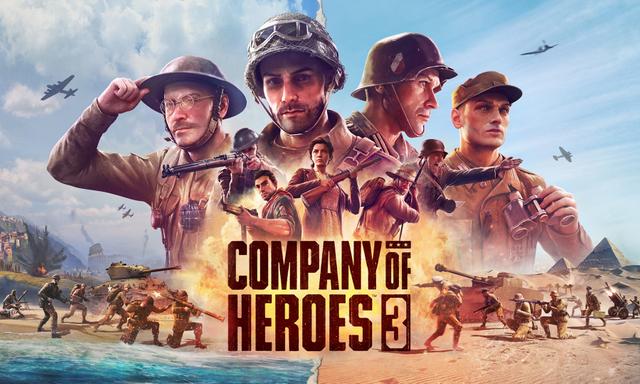The Company of Heroes series started 17 years ago, with the first release in 2006 and since then has become a favourite of real-time strategy (RTS) games, and World War Two fans alike. The realistic settings and attention to detail on the maps and individual models create an immersive experience despite the top-down view.
You feel a connection to each of your units, watching them gain experience throughout the battle until they are an extremely effective fighting force. When one of these top-class units gets into trouble, you’ll often face yourself changing strategy to save them, because of the connection you’ve made and the loyalty to them that has built up.
'Company of Heroes 3' continues on the cover system. Seemingly overwhelming firepower can often be countered with superior positioning and tactics which is often essential through the single-player campaigns. You may find yourself replaying levels over and over, trying to perfectly execute your plan without losing any of your units.
Visuals
The game is visually impressive, with beautifully recreated landscapes from North Africa and Italy. You command your army through barren deserts, still-occupied villages, oases and snowy-covered mountain regions. While it doesn’t have much tactical use, the ability to zoom right in on your squads and vehicles really shows off the developers' attention to detail, with each soldier wearing period-correct attire for their faction, using accurately recreated weaponry and vehicles becoming dirtier and more battle-scarred as the fight wears on.
Performance
The game performed very well overall and developers are continuing to update the game through the release window with performance updates. Depending on the user's hardware and settings there may be FPS drops when rendering water or when there is a lot of action on screen at one time, but none of this was game-breaking, and if you’re running on the recommended hardware spec or above you shouldn’t expect any issues.
Single-player
There are three main aspects to the single-player game. First is the German Afrika Korps North African campaign, the second is the US and British Forces invasion of Sicily and the Italian mainland, and the third is the custom skirmishes you can set up to play against a computer player to test your skills with the different factions on a variety of different maps.
North Africa
The North African campaign seemed to serve as a tutorial. Each mission was relatively easy and there was a lot of hand-holding to guide you through the different objectives. There was an interesting story about a local person and how they unwillingly got drafted to help the English forces and how the war affected their family, but this felt somewhat disconnected from the gameplay once the loading screen was over and a thick German accent started giving you your directions for the next level.
Considering how much media has been created around World War Two, it’s hard to come up with a unique and interesting story in 2023, but allowing the player to control the Afrika Korps helps with this a lot. The game doesn’t try to address the ideology of the Nazi party, and doesn’t try to apologise for the army’s actions in the region, but focuses more on the romanticism of Erwin Rommel – The Desert Fox, his cunning and his army’s victories against the odds, until the turning point and their ultimate defeat.
Italy
The Italian campaign roughly follows the actual path of the Allied invasion in September 1943, but steps away from historical accuracy a bit in order to give more agency to the player. Once the invasion of the mainland has begun, the player is given control of both British and US companies, each with distinct abilities on the Italian Campaign map, and unique units available in battles.
The player uses these companies to move through the Italian countryside, liberating towns and villages, and fighting the Wehrmacht whenever necessary. The story of the invasion is told through set-piece missions on specifically designed maps. These missions are really enjoyable and as they are so different to each other kept the game feeling fresh.
On the other hand, during random encounters with the enemy forces the map and mode were randomized from a set, but after a few of these, they all started to feel the same. Once you get comfortable with a certain playstyle it’s essentially the exact same thing over and over again. Quickly capture the resources you need to create your favourite unit, use those units in their most advantageous way knowing there won’t be any surprises in the match (unlike in the main missions!), win, rinse, repeat.
Skirmishes
Players of most RTS games will be familiar with how skirmishes work. You set different parameters, choose your army, map and win conditions to build your own custom battle. This can be used to try out new tactics and units before taking them online, try to accurately recreate historical battles, or pretty much anything you can think of within the defined parameters. It’s a sandbox for you to create whatever you’d like.
Multiplayer
The multiplayer mode is where a lot of the replayability in this game comes from. Having human teammates and opponents means you’ll never be sure what to expect next. Playing against even the hardest bots will allow the user to figure out patterns and ways to reliably counter them, but against other people that all goes out the window. With four different factions to master – Afrika Korps, British Forces, Wehrmacht, and US Forces, you can learn the basics in single-player skirmishes and then test your mettle online.
Summary
The game looks and plays great, but sometimes suffers from a lack of depth both in unit choice and battlegrounds. Each army seems to have roughly the same choices – standard infantry, machine gun squad, engineers, anti-tank gun, car/recon vehicle, light armour and heavy armour. There does seem to be a meta in the single player at least which was uncounterable by the computer which leads to matches being very samey and sometimes boring. While this was a bit tedious the story/campaign mode also felt a bit short, but maybe it’s not a bad thing that the game is good enough to leave you wanting more?
There is the basis of a great game here and if Relic build on it with more free content it will address most of the issues identified above. If you’re a fan of the previous entries and love multiplayer RTS, you will easily get your money's worth out of this as it is, but if you’re looking for a purely solo experience you might find it difficult to justify a purchase at full price on release.









































































